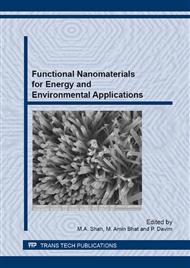[1]
P. Mukherjee, Roy M, Mandal BP, Dey GK, Mukherjee PK, Ghatak J, et al. Green synthesis of highly stabilized nano crystalline silver particles by a non-pathogenic and agriculturally important fungus T. asperellum. Nanotechnology Vol.19 (2008) p.075103.
DOI: 10.1088/0957-4484/19/7/075103
Google Scholar
[2]
E. Mayes, A. Bewick, D. Gleeson, J Hoinville, R Jone: Biologically derived nanomagnets in self-organized patterned media. IEEE Transations on magnetic; Vol.39 (2), (2003), p.624.
DOI: 10.1109/tmag.2003.808982
Google Scholar
[3]
M. Han, Gao, X., Su, J. Z. & Nie, S., Quantum-dot-tagged microbeads for multiplexed optical coding of biomolecules. Nat. Biotechnol. Vol. 19, (2001), p.631–635.
DOI: 10.1038/90228
Google Scholar
[4]
Joseph Wang., Nanoparticle-Based Electrochemical DNA Detection", Analytica Chimica Acta, Vol. 500 (2003), pp.247-257.
DOI: 10.1016/s0003-2670(03)00725-6
Google Scholar
[5]
Moreno Manas, M. 7 Pleixats, R., Acc. Chem. Res. Vol. 36 (2003), p.885.
Google Scholar
[6]
Jose A. Rojas-Chimica and Michael Giersig, J. of Nanoscience and Nanotechnology Vol. 6,(2006), p.3169
Google Scholar
[7]
Tadanori Yaqmada et al., Nature Biotechnology Vol. 21, (2003), 885.
Google Scholar
[8]
Robert A., Freitas Jr.,m JD., Nanomedcine: Nanotechnology, Biology and medicine Vol.1, (2005).p, 2.
Google Scholar
[9]
David S. Goodsell. Bionanotechnology:Lessons from Nature. John Wiley & Sons, Inc., Publications (2004)
Google Scholar
[10]
S.Shankar ., A.Rai ., A. Ahmad .,Muraly Sastry ,Nature Materials. Vol. 3 (2004). P. 482
Google Scholar
[11]
Balaprasad Ankamwar, Synthesis and Reactivity in inorganic, Metal- Organic and Nano_Metal Chemistry Vol.35, (2005) ,p.19
Google Scholar
[12]
S.Shankar ., A.Rai ., A. Ahmad .,Muraly Sastry, Biotechnol. Prog. Vol. 19 (2003), p.1627–1631.
Google Scholar
[13]
Mukherjee P, Ahmad A, Mandal D, Senapati S, Sainkar Sudhakar R, Khan MI, et al.Fungus-mediated synthesis of silver nanoparticles and their immobilization in themycelial matrix: a novel biological approach to nanoparticle synthesis. Nano Lett. Vol.1 (2001), p.515–9.
DOI: 10.1021/nl0155274
Google Scholar
[14]
P. Mulvaney; Surface Plasmon Spectroscopy of Nanosized Metal Particles; Langmuir; Vol.12 (1996), p.788.
DOI: 10.1021/la9502711
Google Scholar
[15]
Ahmad A, Mukherjee P, Senapati S, Mandal D, Khan MI, Kumar R, et al. Extracellular biosynthesis of silver nanoparticles using the fungus Fusarium oxysporum. Colloids Surf B Vol. 28 (2003), p.313–8.
DOI: 10.1016/s0927-7765(02)00174-1
Google Scholar
[16]
Shankar SS, Rai A, Ahmad A, SastryM. Rapid synthesis of Au, Ag, and bimetallic Au core–Ag shell nanoparticles using Neem (Azadirachta indica) leaf broth. J Colloid Interface Sci Vol. (2004), p.496–502.
DOI: 10.1016/j.jcis.2004.03.003
Google Scholar
[17]
Sukdeb P, Yu KT, Joon MS. Does the antibacterial activity of silver nanoparticles depend on the shape of the nanoparticle? A study of the Gram-negative bacterium Escherichia coli. Appl Environ Microbiol 2007;73:1712-20.
DOI: 10.1128/aem.02218-06
Google Scholar
[18]
Bhattacharya R, Mukherjee P. Biological properties of "naked" metal nanoparticles. Adv Drug Deliv Rev Vol.60 (2008), p.1289–306.
Google Scholar
[19]
Kumar SA, Majid KA, Gosavi SW, Sulabha KK, Renu P, Absar A, et al. Nitrate reductase mediated synthesis of silver nanoparticles from AgNO3. Biotechnol Lett 2007;29:439–45.
DOI: 10.1007/s10529-006-9256-7
Google Scholar
[20]
Durán N, Marcato PD, De Souza GIH, Alves OL, Esposito E. Antibacterial effect of silver nanoparticles produced by fungal process on textile fabrics and their effluent treatment. J Biomed Nanotechnol 2007;3:203–8
DOI: 10.1166/jbn.2007.022
Google Scholar
[21]
Vigneshwaran N, Ashtaputre NM, Varadarajan PV, Nachane RP, Paralikar KM, Balasubramanya RH. Biological synthesis of silver nanoparticles using the fungus Aspergillus flavus. Mater Lett 2007; 66:1413–8.
DOI: 10.1016/j.matlet.2006.07.042
Google Scholar


